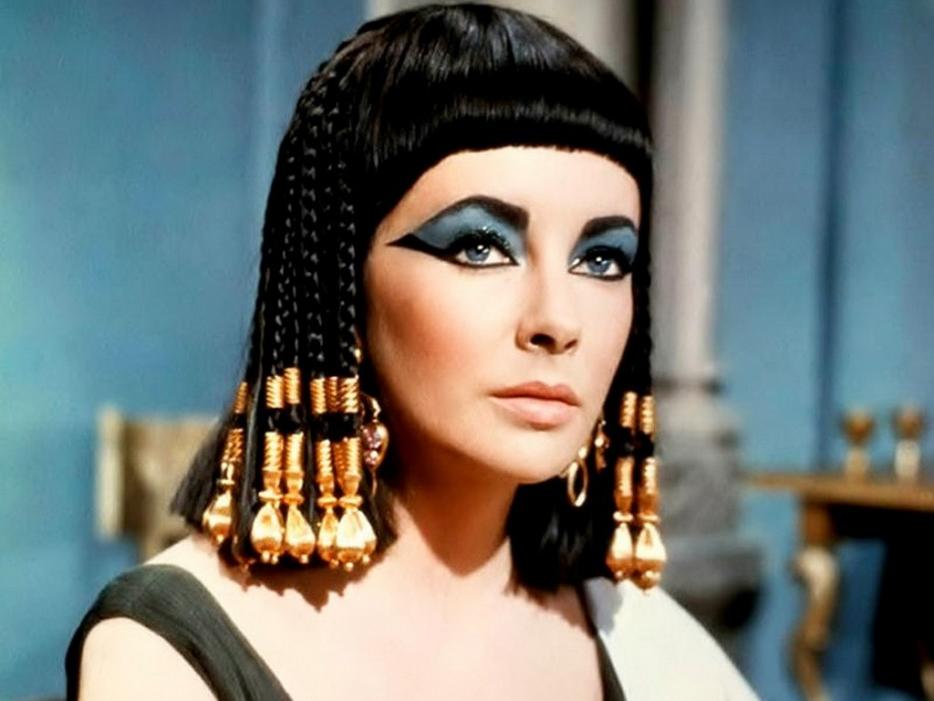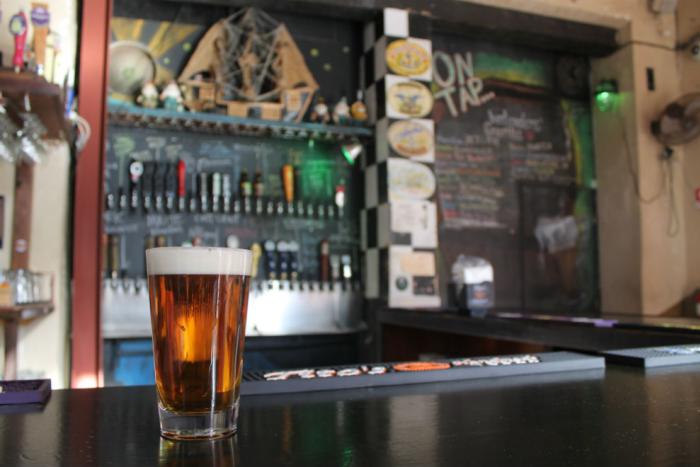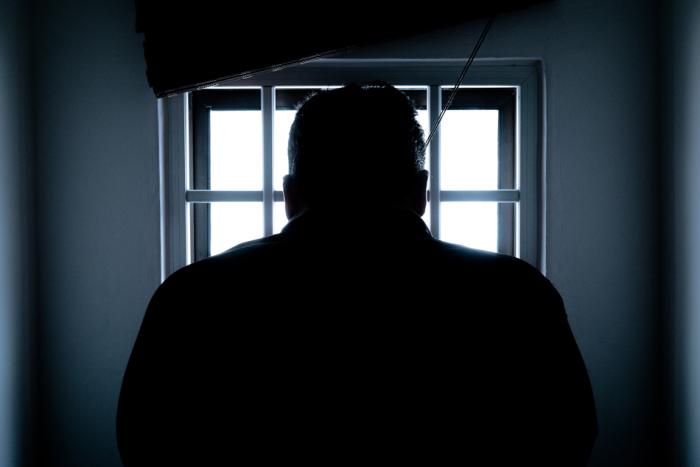In Rome in 1962, one of the biggest movie stars in the world got ready for work. On a regular day, if there ever was one for Elizabeth Taylor, that meant she would do her own makeup. At $1 million, Taylor was earning the highest salary for a female actor ever at that time, and the film she was making, Cleopatra, was one of the most expensive in Hollywood’s short history, with a budget of $44 million. The original makeup artist for the film, Alberto De Rossi, became ill early on in the long, long filming process. So, as she often did in her pictures, Elizabeth did her makeup herself.
In the film, she appears on screen in a bright blue dress with a leopard print coat; she wears an emerald green floor length gown; she wears nothing but a sheet. No matter the costume, her eyes—those big, beautiful, moneymaking blue eyes—were framed in thick cat eye liner with blue shadow from her lashes to her eyebrows. Elizabeth had seen what De Rossi did and was able to copy it, likely drawing on her years of experience protecting and creating her image, and knew just what shade of blue made the whites of eyes look whiter and irises bluer.
She often kept that blue eye shadow on after she left set for the day, sometimes on dates with Richard Burton, who played Mark Antony, during the period when their love affair became front page news around the world. These pictures helped spark a makeup trend. “Elizabeth Taylor made the public want to buy what she already had to give,” said William Mann, author of How to Be a Movie Star: Elizabeth Taylor in Hollywood. Her eyes are one reason she was famous. Her relationships with men were another. But what really made Elizabeth a star was Elizabeth—her authentic-seeming honesty, the control she had over her life outside of the Hollywood studio system, and her wild, irrepressible charm.
No one else could be Elizabeth Taylor on yachts with her men and her jewels, but you could at least wear the same makeup.
*
Highly visible cosmetics, like Taylor’s blue eye shadow, have a fractured history both in England, where she was born, and in the United States, where she started working as an actress after her family moved to Los Angeles in 1939. During periods including the Victorian era, women in the U.S. and England were condemned for wearing obviously painted faces, wrote historian Madeleine Marsh in her book Compacts and Cosmetics. According to Marsh, the rise of Christianity brought with it an attitude that using cosmetics was a sinful luxury that falsified the work of god. Obvious makeup went in and out of fashion: white face paint and exaggerated rouge indicated aristocracy for both men and women around the late 1500s and 1700s, and then fell out of favor once again. Marsh wrote that women could get away with wearing makeup so long as it wasn’t obvious—only if women needed it to fit strict conventions of beauty, which tended to be centered on white women. A rise in the manufacturing and availability of cosmetics in the 1910s and 1920s in the U.S. and images of actresses like Theda Bara—who spawned the “vamp” look of dark eye and lip makeup—prompted more obvious makeup trends like bold lips. But women who participated in more visible makeup, like flappers, were often not viewed as respectable.
Blue eye shadow does anything but look natural. There’s no way to hide that you’re wearing makeup if your eye shadow is electric blue, just as there’s nowhere to hide in the world when you step out with it on. Elizabeth particularly embodies this—she couldn't hide from her fame and was known for embracing glamour.
In one of Elizabeth’s less popular films, The Driver’s Seat, she puts on blue eye shadow with a tiny makeup brush, thinner and shorter than her finger. You can’t see where she dips the brush, so the color appears as if it’s springing from her pores. Looking off screen, Elizabeth’s hand is steady as she quickly puts color on her eyes, giving the impression she has done this many times before. To watch her feels voyeuristic, the viewer becoming a part of a long tradition of sneaking around to learn the secrets of womanly trade.
A short clip of this scene showed up on YouTube in 2011, and celebrity makeup artist Mario Dedivanovic posted it on Instagram in 2016, sparking a small flurry of discussion on the Internet about how Elizabeth Taylor did her makeup, showing the lingering fervor for her glamour even five years after she died.
This scene is literally depicting the work of putting on makeup, but Taylor still makes it look effortless. The makeup brush acts as an extension of her hand; a coy peek over her sunglasses when she finishes seems natural.
Putting makeup on in public had generally been taboo for women since ancient Rome, until after World War II in the U.S., when using a powder compact became a status symbol. So women mostly shared and discussed cosmetics with female family members or other women in the know to pass down beauty secrets. Part of keeping makeup application hidden from the outside world was to hide the effort it took to exist as a woman in public, Autumn Whitefield-Madrano wrote in her book Face Value. But Elizabeth’s beauty embodied the ease women are supposed to display even while doing the work it takes to become a made-up woman.
*
In a world where women are often flattened to the images and roles they represent, a woman in control of her makeup—or lack thereof—is more in control of her life. But blue eye shadow has become pop culture shorthand for a woman who has too much power and too little control over it. Blue eye shadow is sometimes used to indicate a crazy woman, a witch, or a bitch (and Elizabeth has been viewed as all of those, and more).
Elaine (Samantha Robinson) in Anna Biller’s 2016 film The Love Witch uses sex and love spells to make men fall in love with her and then kill them when she tires of them. Elaine exhibits extreme narcissism, craving affection and attention from men and punishing them when they don’t live up to her unrealistic ideals. She tries to embody men’s fantasies, and part of that is in the way she looks: long black hair, lacy lingerie, and bright blue eye shadow. Her femininity is exaggerated as she becomes the perfect archetype of a seductress. Her spells are so strong, and she is so captivating, that men feel overcome by their love for her. But when they don’t live up to her own fantasies, it ends in death.
This deadly explosion of feminine power is also depicted in Cleopatra. As the young queen of Egypt, Cleopatra falls in love with Julius Caesar, the most powerful man in ancient Rome. Her love seems genuine, but it’s also advantageous to have his power on her side. After Caesar is assassinated, one of his generals, Mark Antony, declares his love for Cleopatra. Together, Antony and Cleopatra try to unite Rome and Egypt. They fail, and commit suicide. Throughout it all, Cleopatra emphasizes her sexuality and power through her clothing and makeup. Blue eye shadow again represents a woman who uses her particularly female power as a sexual being and a queen, and then loses control of where that power takes her.
*
The real Cleopatra is often believed to have worn blue eye shadow, a notion bolstered in part by Elizabeth’s portrayal of her in the film. Madelaine Marsh wrote that Cleopatra wore a blue-black on her upper lids, and green at the bottom. Historian Andrew Hardy wrote that it’s likely Cleopatra’s eye makeup wasn’t blue at all. Eye makeup in ancient Egypt was most commonly green or grey because of the minerals malachite and galena that were used to make it, according to Classic Beauty: The History of Makeup by Gabriela Hernandez.
Autumn Whitefield-Madrano quotes in Face Value a woman who describes bright makeup as associated with childhood; Marsh shares a similar sentiment: “For little girls, experimenting with lipstick and eye shadow is part of the initiation ceremony into a grown-up world … and whatever your age, playing with makeup is fun.” William Mann speculated that Elizabeth wore her makeup from the set of Cleopatra out after work because she liked it, and there may be nothing more to it than that. But it also allowed Elizabeth to emphasize her childlike playfulness, even though she was a mature woman. “To understand Elizabeth—she was like a little girl. She still had the innocence and the spirit of adventure that a little girl would have,” Mann said.
By the time she made Cleopatra, Elizabeth had been married four times, become a widow once, had three children, and adopted a fourth while she was filming. She had survived an abusive marriage and had been working, and helping to support her family, since she was nine. But people still viewed her as childish and innocent.
Elizabeth was not meek; she worked to control her life and stuck up for herself from the time she was fifteen, when she walked out of Louis B. Mayer’s office during one of his tirades and refused to apologize to him. She had a million-dollar salary for Cleopatra because she worked with her agent to get it on her own, outside of the structure of a film studio. Using blue eye shadow allowed her to be seen as fierce and innocent at once.
In her obituary in the New York Times, Cleopatra director Joseph Mankiewicz described seeing Elizabeth for the first time when she was eighteen years old: “She was the most incredible vision of loveliness I have ever seen in my life,” he said. “And she was sheer innocence.” Fierceness allowed her to make money on her terms; sexuality behind the veneer of innocence is often what she was selling.
To embrace makeup is to embrace certain contradictions: using cosmetics to look natural or being seen as a decorative object while taking control of that decoration. Often being a woman in public is to live in those in-between spaces, and becoming comfortable with makeup, for those who choose to wear it, is in part to grapple with those conflicts. Simultaneously seductive and subversive, blue eye shadow is particularly emblematic of this push and pull. Elizabeth turned to blue eye shadow throughout her life, harnessing its power to focus on her most valuable physical attributes: her eyes, but also her womanhood. By using it to make up her face, she created the life she wanted—as an actor, a star, and a woman.






